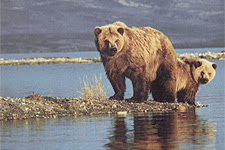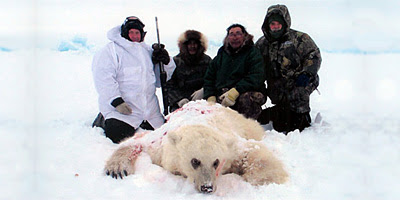 A recent issue of Nature celebrated Linnaeus’ 300th birthday with a series of editorials, essays and features on the continuing work of taxonomists. One of the more provocative articles discusses the definition of species, including the status of the beloved polar bear, Ursus maritimus.
A recent issue of Nature celebrated Linnaeus’ 300th birthday with a series of editorials, essays and features on the continuing work of taxonomists. One of the more provocative articles discusses the definition of species, including the status of the beloved polar bear, Ursus maritimus.
 Polar bears are more closely related to some brown bears (Ursus arctos) then some brown bears are to each other. While the interrelationships of these species (and subspecies) is a surprise, it has long been known that the animals are closely related and has been evidenced (rarely) by the hybridization of the polar bear and the grizzly bear, Ursus arctos horribilis.
Polar bears are more closely related to some brown bears (Ursus arctos) then some brown bears are to each other. While the interrelationships of these species (and subspecies) is a surprise, it has long been known that the animals are closely related and has been evidenced (rarely) by the hybridization of the polar bear and the grizzly bear, Ursus arctos horribilis.
This hybrid, though extremely rare, has occurred in captivity and has long been storied in arctic legends. In 1864 biologist, Clinton Hart Merriam, described an animal killed at Rendezvous Lake, Northwest Territories, Canada as "buffy whitish with a golden brown muzzle". A century later, Clara Helgason remembers a bear shot by hunters on Kodiak Island during her childhood in 1943 as "a large, off-white bear with hair all over his paws".
The most recent sighting of the rare hybrid was made, unfortunately, after its death. On April 16, 2006, Jim Martell, a sport hunter from the United States, shot a grizzly–polar bear hybrid near on Banks Island, Northwest Territories, Canada. Martell had paid $50,000, for an official license and a guide to hunt polar bears in Canada’s arctic. 
Martell shot what appeared, at a distance, to be a polar bear but officials noticed that beyond the thick, creamy white fur, typical of polar bears, the animal also had long claws; a humped shoulder, scoop-shaped snout and brown patches around its eyes. The hybrid was confirmed by a DNA test.
The government returned the carcass to Martell. Though the hybrid species has no conservational value (like white tigers ), it is an amazing phenomenon and I am sad the hunter kept his prize. I think he should have been compensated and asked to donate the pelt to a museum where others could learn about the phenomenon.
Lastly, I will note that the US government is considering giving polar bears a ‘threatened’ status. The Canadian government has a different perspective as anecdotal evidence from aboriginals and official wildlife surveys indicate the polar bear population in Canada actually appears to be growing. This of course is a notion that doesn’t appeal to Prime Minister Steven Harper, as he is a proponent of climate change and the growing polar bear population does not fit well into his campaign. But that is a debate for another posting.
Regardless of controversy surrounding these amazing animals I hate that the government advocates rich people throwing out $50,000 for the opportunity to shoot one of these creatures. It is one more example of how Canada continues to sell its natural resources and decimate its environment for a few greenbacks.
Marris, E. 2007. Linnaeus at 300: The species and the specious. Nature 446, 250-253.
Roach, J. May 16, 2006. Grizzly-polar bear hybrid found -- but what does it mean? National Geographic News.





Comments